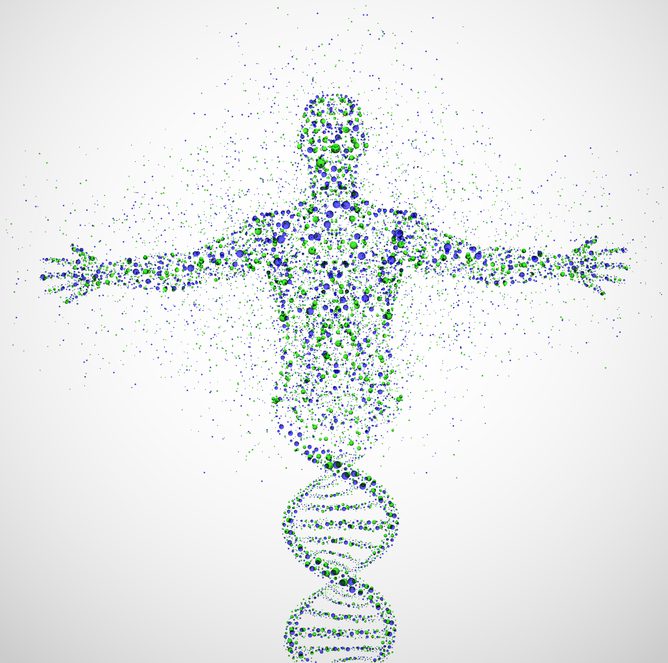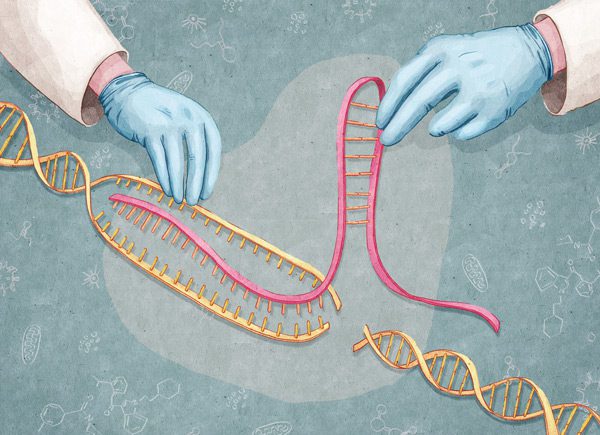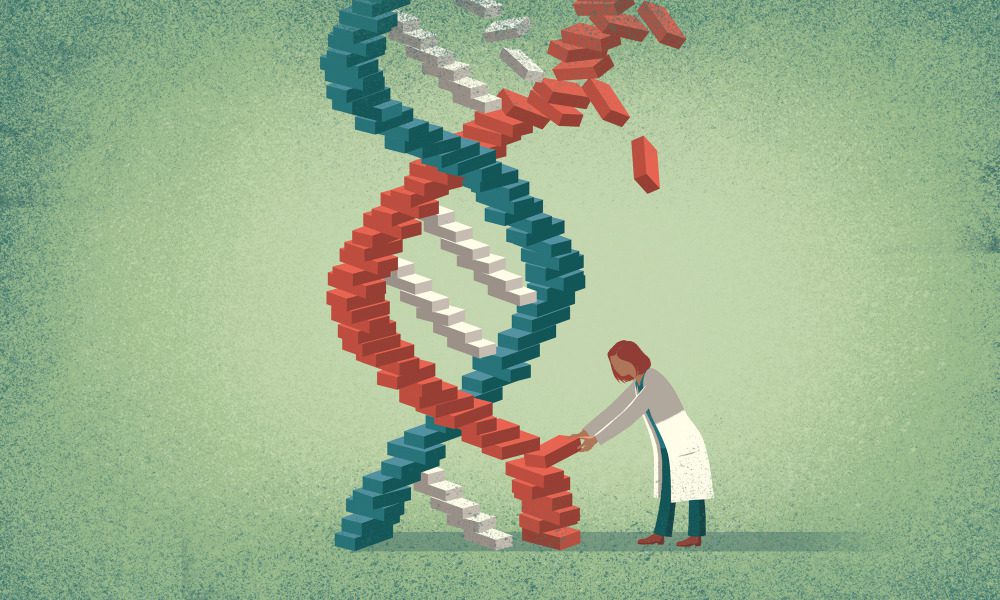About a hundred thousand years ago, the first ‘modern Humans’ appeared on Earth. We, like all species, have been on an evolutionary roller coaster, and the ride is endless, or so it seems.
Left to its own devices, nature imposes selection on all the living organisms and drives them to evolve. And so it has been for time immemorial. And may continue to do so even in the future. But one rebellious species seems to be headed to take over the rein of their fate in their own hands. Humans.
Related: What’s next in human evolution?
Over the last few decades, genetic manipulation has grown manifold in terms of potential. That’s not necessarily scary, though. Genetic manipulation could lead us to our freedom from the selective clutches of nature. Or will it be a double-edged sword, leading to divergence in our society?
All the information needed by our body is present in our cells, encoded within the genes present on our DNA. As we evolve, we change; these changes occur at the molecular and genetic level, which is reflected in our phenotype.
Our genome is thus a repository of our present and a comment on our history. And it is different today than the one we started out with when we first appeared on Earth. Moreover, there are inherent differences amongst our present forms too. As we migrated to different parts of the world, we adapted to the changing environs, thus collecting various changes in our genomes. These locale-specific changes have amassed differentially in various populations and have contributed to the formation of different ethnicities, tribes and ‘races’.
There are cases of inherent adaptations specific to locations in other species also; but they too are regarded as tribes of one species. Take the case of Heliconious butterflies. In order to stand out and warn off potential threats, these creatures have elaborate and colorful wing patterns, their patterns vary according to the predatory bird populations of different areas, thus a wide array of wing patterns are present. But essentially all the Heliconious butterflies are the same biological species. In humans, changes have occurred at different times in different parts of the body, unlike the one difference in the mentioned butterfly species.
But these differences aren’t drastic, seeing how we still continue to flourish as one species, with viable interbreeding. At least, that is one way of discrediting racial discrimination that occurs on the basis of just 0.5% of our genes. Genetically, all the humans are 99.5% similar!
Related: Why aren’t we cloning humans yet?
But there exists a school of opinion in scientists and sociologists who have come up with a counter-argument. Genetically humans and chimpanzees differ 3%. Is it then a stretch to imagine that even the 0.5% difference amongst us is of some significance? Often misconstrued as racism, this direction of thought doesn’t seek to imply superiority of one race over the other. It merely aims to point out that there exists a genetic separation, however minute, so maybe we could reinforce it positively instead of divisively. The changes have persisted because they benefit us.
Genetic Manipulation for Disease Eradication?
Some populations of South Asia and Africa have developed resistance to malaria. This isn’t an isolated case – it is one among several of cases where the changes in certain populations have led to a better chance at life. The consumption of certain products, say dairy, has been prevalent in some areas since several hundred years and has led to some of us being able to digest it.
We might be headed towards a mono-ethnic society due to increased interbreeding and globalization. But will we then lose a treasure trove of options? Perhaps there is some way to find the ‘best’ in each group and incorporate them in our genome? Imagine incorporating ‘useful’ genes from one population into the genome of another, across the globe? Gene editing may be the way to achieve this.
Related:
Gene editing is simply manipulation of genes. With the advent of genetically modified plants and their accompanying controversies, gene manipulation is grabbing eyeballs globally. There was a sudden deluge of Genetically engineered organisms (GMOs) in all aspects of our lives – GM lab animals for research, GM plants for feeding, and GM animals, even GM fish for pets (Glofish, remember?). But there was also a lot of opposition from many researchers as well as public on grounds of safety and ethics. Scientists agreed that there was a long road ahead before human genes should be tampered with. Has that road reached its destination? A lot of diseases, like sickle cell anemia, are due to disruptions in a single gene. Theoretically, molecular scissors like TALENs (Transcription activator-like effector nuclease) can be used to cut specific parts of the gene, which can be replaced by genetically engineered healthier portions of the excised gene.
Though effective in a lab, these procedures possess great risks at the moment. It might be difficult to ensure that no healthy genes get cut; or that the replacement be successful. What will be the unexpected effects on a live human being? But there is hope that this method will be refined and cleared for medical purposes soon.
HIV messes with our T-cells, part of our immune system, thus rendering us weak and susceptible to a horde of infections. The virus, in a way, latches onto these T-cells. It achieves this because of the presence of CCR5 receptors, which unwillingly become the hook and anchor for the virus. If the gene for these receptors was to be edited out, the virus will no longer be able to affect us. Then why is it this not been done for every HIV affected person? Because in an actual living human being (or any organism, for that matter), the implications are manifold. Such research is feared and shunned, aside from the additional problem of it costing excess money.
There is another form of gene editing – embryonic manipulation. Embryonic manipulation sounds like a great tool at first. It has the potential to be helpful for kids whose developmental issues are tracked early on. But it’s fraught with its own set of issues. Some embryonic modifications can be seen as germ-line heritable changes. These are the kind of changes that the individual will pass on to its progeny. Essentially, it translates to modifying the genetic legacy of humans.
We also possess a mitochondrial genome in us which is handed down by our mothers. The rate of evolution in this is slower, and so it is used to trace phylogeny. But our mitochondrial DNA can also be mutated in our lifetime, and lead to various diseases. There is a risk of some mitochondrial genetic problems carrying on to the next generation too. In such a scenario, it is possible for the mother’s nucleus (and so her nuclear DNA) to be inserted in an enucleated egg cell, creating a composite egg cell – having the nucleus of mother and healthy mitochondria of the donor. This egg can then be fertilized with the sperm of the father. The child will thus be an offspring a three parent system! Other in-vitro fertilization options have also come up which may change the dynamics of the social structure prevalent today.
Because of several secretly funded and closed door studies, genetic manipulation is a dynamic and frightening field. If gene editing was to become an unregulated norm, the ones with money will seek to remove all genetic obstacles to a long healthy life. Expect further divisions in our world already reeling under severe wealth disparity. Due to regulations and obvious risks, it has been difficult to do conclusive research on human embryos.
Related: A Noob’s Guide to CRISPR
Maybe rightly so. After all, if the ingenuity of human mind met with the roguish nature of power and money, the situation may become dire.
As genetic technology continues to evolve, we’re going to need better laws. The thought of designer babies, with pre-decided traits, is not only an unnatural one but also a socially divisive one. There’s also a solid possibility of development of bio-weapons that can be used to target specific groups of people owing to the genetic differences in different populations. This is a racially exclusive and dangerous tool. And we know there are humans on the planet who could use it for all the wrong ideas.
If we consider the prospective use of gene editing in tweaking our abilities, expanding out tolerant environmental factors and overall strength; a race of super-humans with heightened abilities is a distinct possibility. This may be an achievement from a militaristic point of view; but it could end up messing the fragile balance between different ethnicities, probably will. Will these genetically upgraded humans not treat the ‘naturals’ as being inferior?
So far, evolution has been nature playing a game of probability. But now, it’s like nature is giving us a dice we can load ourselves. Will we win the game together or fragmented?







